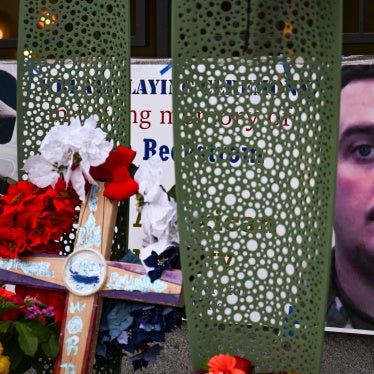Burma’s President Thein Sein and his close advisers have reaped widespread kudos for their brokering of preliminary ceasefire talks with more than a dozen ethnic armed groups over the past several months. In early April, the government reached an agreement with the Karen National Union (KNU) to end a secessionist conflict that has alternatively simmered and boiled since 1949, following on from similar agreements with 11 other insurgent groups.
The enthusiasm for ceasefires has been tempered by ongoing fighting in Burma's northern Kachin State between the Burmese government and the Kachin Independence Army (KIA) after the breakdown of a 17-year ceasefire in June 2011.
As in all insurgencies, the political, economic and social motivations for ongoing conflict are complex, but the US Central Intelligence Agency (CIA) identifies a core grievance that has fueled recruitment to the KIA: "Ruthless and poorly focused GUB [Burmese government] suppression operations such as the burning of an entire village ... the forced transfer of the entire population of Kachin villagers from insurgent infested areas ... enough instances of rape, knifing and chicken-stealing to foster bitter resentment among the Kachin."
Recent reporting on the ground by Human Rights Watch and others uncovered many such abuses against the civilian population and the displacement of more than 75,000 people. The violations documented in Kachin state are the product of similar tactics employed against ethnic Karen, Karenni, Shan and Mon communities in eastern Burma for years.
The CIA's declassified intelligence report was actually produced in April 1970, several years into the earlier Kachin insurrection. Its eerie verisimilitude to abuses such as sexual violence, attacks on villages, forced displacement, forced labor, torture, and rampant plundering of private property experienced in recent months demonstrates a core factor in Burma's long-running civil conflicts: the enduring culture of abuse and impunity within the Burma military against ethnic civilian populations.
The pace of change in Burma over the past year has been dramatic, with the government promising sweeping economic and political reforms and long oppressed opposition leader Aung San Suu Kyi winning a seat in parliament on April 1. Censorship has been loosened, hundreds of political prisoners have been allowed to return to their families, preliminary ceasefire talks with armed groups have begun, and even official rhetoric on human rights has changed, from hitherto blanket denials of rights violations to grudging official acknowledgement.
The ceasefire talks have broached a litany of difficult issues to resolve: return of refugees and internally displaced persons, clearing of landmine infested conflict zones, humanitarian access, land rights, and long-standing political and cultural issues.
In his state of the union address to parliament on March 1, President Thein Sein outlined the government's three-step approach to attaining "eternal peace" in Burma. The first step is to conduct preliminary dialogue at the state level, the second aims at the national level to address issues such as development, constitutional amendments, and working towards "a single armed force," while step three will be a political process to achieve "mutual understanding, equality and development."
But one institution that has not changed is the defense services, or Tatmadaw, the crucial absent variable in the reform process. Reaping the benefits of a constitution that they largely drafted, military officers hold 25% of the unelected seats in all national and regional parliaments, have one of the vice-presidential slots, three key ministries, defense, home affairs and border affairs reserved for generals, total control over the military budget estimated at 20% of gross domestic product, and immunity for all service personnel from civilian prosecution.
Ongoing violations against ethnic communities have barely been mentioned in the optimistic accounts of reform. The Burmese military in ethnic areas is poorly resourced, under-supplied, and predisposed to punish civilians for their perceived support for rebellion. Local ethnic populations widely view them as an army of occupation, dangerously pursuing counter-insurgency on the cheap. This punitive approach hasn't stamped out resistance, it has fueled it.
At the same time, many ethnic armed groups have also been implicated in serious human rights abuses against their own communities and the Burmese army. These have included use of child soldiers, widespread use of anti-personnel landmines and the execution of prisoners.
Ask any civilian in the conflict areas of eastern Burma what they want for the future, as I have done on a regular basis for more than a decade, and it is peace and justice, and an end to violent opportunism by all men with guns: government soldiers, ethnic insurgents, pro-government militias, and drug bandits.
Any peace negotiations should include putting into place mechanisms that would ensure the protection of human rights. To this end, negotiations between the Burmese government and the Karen National Union have included drafting codes of conduct for both sides' forces: towards each other and how they treat civilians.
Belated admissions
In mid-May, high ranking Burmese military officers joined the peace talks, when Lieutenant General Soe Win, the deputy commander in chief of the defense services, and three generals commanding the regional military command zones in Eastern Burma met with leaders of the rebel Shan State Army (SSA) in Kengtung in Shan State, the first time such senior commanders have met with their long-time opponents in such negotiations. The military 'buying-in' to the peace process will potentially provide a unique opportunity to raise impunity for human rights abuses.
In his inaugural speech to parliament in March 2011, Thein Sein admitted that people living in conflict areas had been enduring a "hell of untold miseries." One of his close advisers, Ko Ko Hlaing, like the president a former military officer, admitted to Western reporters in November that the military had perpetrated abuses: "As you know there are no clean hands in conducting all sorts of war. There may be some sort of crimes committed by government troops similar to other armed forces of the rest of the world."
Many senior government officials are former Tatmadaw commanders: they know better than most how the army conducts operations. The main peace negotiator for the government, Railways Minister U Aung Min, has gained widespread plaudits for his skillful negotiating efforts, avuncular manner and honesty. He is also a former commander of the 66 Light Infantry Division, a reputedly ruthless unit that operates in eastern Burma, particularly Karen State.
Transforming the army's abusive counter-insurgency strategy is key to durable peace and long-term development, yet few international observers are even broaching the subject. Officials have assured foreign diplomats that human rights training is part of the curriculum of the prestigious Defense Services Academy that trains Burmese military officers, and that the Geneva Conventions of 1949, to which Burma is a party, are in Burmese language translation.
But training means little so long as commanders do not demonstrate a willingness to abide by the laws of war, enforce discipline in their troops, and appropriately punish perpetrators of war crimes. As international engagement with the Burmese government scales up to support the nascent reforms, so too should progressive rapport with the military. It will ultimately be up to the Tatmadaw to show its commitment to reform through its actions on the battlefield and willingness to tackle violations of the laws of war.
The Tatmadaw is not completely obtuse to international legal norms. Since 2007 it has cooperated with the International Labor Organization on demobilizing child soldiers, as part of an agreement on forced labor. The use of child soldiers is prohibited in Burmese military regulations and international conventions to which the country is a party. The ILO's activities pushed the authorities to punish 166 military personnel - 27 officers and 139 enlisted men - for breaches of the forced labor and under-age recruitment laws over the past five years.
The military and police also cooperate with the United Nations Children's Fund (UNICEF) and other UN bodies in training to stamp out child soldier recruitment. These efforts may pale when the breadth of abuses and the culture of impunity within the military are still pervasive, but they demonstrate that engagement on serious human rights concerns can work. They need to be expanded to encompass a range of other violations, and push the army to punish perpetrators.
The Burmese government's recent changes have been enough to sideline calls from a dozen countries for an international commission of inquiry into serious violations of the laws of war. But this doesn't mean such violations have been reduced, that future abuses aren't likely, or that accountability for crimes should be postponed. Only when the pervasive culture of abuse within the army is seriously addressed will Burma's hopeful changes become genuine reforms.
David Scott Mathieson is Senior Asia Researcher at Human Rights Watch.








